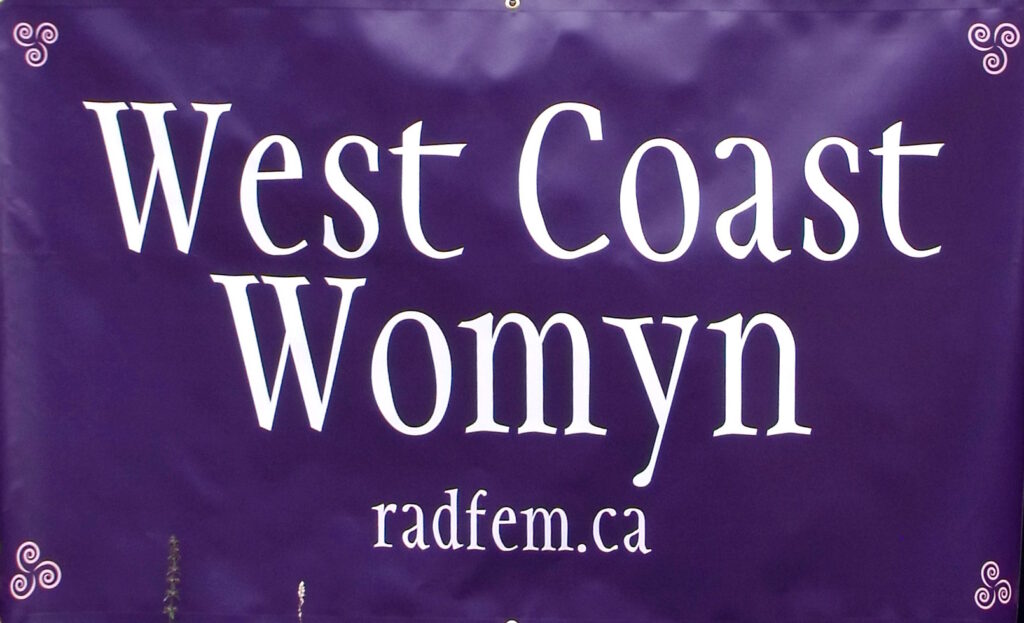Launching the
Bear Mountain boycott at Bear Mountain’s sales office in Langford. Photo: Pete Rockwell
April 16, 2008
Stew Young, the blustery mayor of Langford, BC, hates to hear the word “no.” When the Municipal Finance Authority declined to finance his pet project, a controversial and environmentally destructive highway interchange, he was furious. Now the city is trying to get the cash from TD Bank (formerly Toronto Dominion.) Not only that, but the city is pulling all its accounts from the provincial authority and seeking to transfer them to the private bank.
Stew makes it sound like a done deal, but that’s because he hasn’t felt the full force of the paper monkeywrench. TD Bank knows what I’m talking about, though. Rainforest Action Network has been pressuring the bank for ten years to stop funding environmentally destructive projects. “TD Destroys Rainforests” was the rallying cry. They plastered stickers on ATM machines and picketed at AGMs. Six months ago, the bank gave in and signed a comprehensive Environmental Policy and Environmental Management Framework endorsed by RAN and ForestEthics.
So, what are the odds the bank will go ahead and fund the Bear Mountain Interchange, given this history and the horrific damage the project is already inflicting on rare species and sacred caves and the landslide of bad publicity the Bear Mountain Resort gets every week? Anyone want to make a bet?
Below is some background from today’s Times Colonist, followed by my letter to TD Bank’s Enviromental Affairs manager.
Langford Pulls Plug on Municipal Finance Authority
Still smarting from what Langford Mayor Stew Young calls “appalling” treatment from the Municipal Finance Authority, Langford has refinanced its existing $11.4-million municipal debt with the MFA, placing it instead with a chartered bank.
Langford had sought permission to borrow up to $25 million on behalf of five developers in connection with the interchange under construction near Spencer Road at the Trans-Canada Highway. The proposed move sparked a mock counter-petition protest that gathered more than 2,250 signatures of Langford residents who believed they should have been consulted.
The plan was for the municipality to borrow the money from the MFA at a preferred rate, with the loan guaranteed through the developers’ property in the area, worth about $135 million. But when the province asked the MFA to comment on the proposed borrowing, the MFA said it would categorize the loan as “non-traditional” and would want a letter of credit from the developers — something that would push up borrowing costs.
That incensed Young.
“When you look at it from a bank’s point of view, I’m a customer. When you look at it from the MFA’s point of view, I’m a customer. Who craps on their customer?”
City Council voted last week to take their business to TD Bank – as usual, without consulting anyone else. It’s worth noting this council faces re-election in November. Anyone want to give odds that they’ll survive?
The Paper Monkeywrench (or Full Disclosure in the Public Interest)
Lillian Ranalli
Senior Manager, Corporate Environmental Affairs
Government and Community Relations
TD Bank Financial Group
66 Wellington Street West, 10th floor
Toronto, ON M5K 1A2
April 15, 2008
Dear Ms. Ranalli,
We are writing to advise you on the environmental and social risks of approving a credit application by the City of Langford on behalf of Bear Mountain developers and the proposed Spencer Road Interchange (also known as Bear Mountain Interchange.)
We would like to commend TD Bank on its community-based environmental initiatives, and for committing to “take reasonable care to prevent or avoid environmental incidents associated with our operations.” Due to mounting public concern over loss of First Nations cultural sites and environmental degradation in Langford, we are obliged to disclose that the interchange project contradicts many of TD Bank’s commitments as outlined in its Environmental Policy and Environmental Management Framework. Therefore, we strongly recommend that TD Bank implement enhanced due diligence when assessing the Langford application.
We ask you to consider the following risks and liabilities inherent in this project.
· The interchange project is wiping out irreplaceable First Nations heritage sites. The highway interchange will damage or destroy a significant cave used by First Nations for hundreds of generations. A second sacred cave was demolished at Bear Mountain Resort last year.
· Interchange construction is already eradicating endangered ecosystems and vulnerable species. Chainsaws and bulldozers have leveled several groves of Garry Oaks, which represent the rarest ecosystem in Canada, and degraded pond habitat for Red-Legged Frogs, a federal and provincial Species at Risk.
· Litigation to address First Nations rights and remediate environmental damage is under consideration. Court-ordered environmental remediation could potentially cost hundreds of millions of dollars.
· Langford’s proposal to borrow money for the project is strongly opposed by over two thousand Langford voters and by the majority of Vancouver Island residents. The city has exempted the loan from the usual referendum vote.
· The financing request was previously rejected by the Municipal Finance Authority, which noted the irregularity of the city acting on behalf of private developers and also expressed concern about financial risk and credit capacity.
First Nations sites destroyed
The destruction of the Spaet Cave has ruptured relationships with First Nations. The area of Spaet (Skirt) Mountain is a shared place for ritual going back hundreds of generations. The Tsartlip First Nation, one of the bands with a claim and treaty rights to the area, has been shut out of negotiations with the province and the developer. Two neighbouring bands signed an agreement to allow construction on the mountaintop to proceed in exchange for compensation. Meanwhile, the Tsartlip First Nation rejected the deal, and was subsequently – and illegally – locked out of official meetings. (“Tsartlip veto Skirt Mtn. cave deal,” Times Colonist, Dec. 20, 2006). The only remaining remedy is a potentially costly and disruptive court battle.
After the agreement was signed, the cave was demolished. The underground pool was drained and the cavern was filled with truck tires and stumps while blasting took place. The roof of the cave was removed and the surrounding area bulldozed. The stumps and tires were later removed but the cave was never rebuilt.
A second cave, also identified as a shared cultural site for local bands, is located in the path of the Bear Mountain Interchange near the Trans-Canada Highway. It has been permanently damaged by the blasting and excavation splitting open underground caverns connected to the main cave. The City of Langford promised to “protect” the cave, but instead city workers drilled and welded a rebar grate over the entrance and piled tons of broken rock on top of the rebar earlier this year. The cave is no longer useable by speleologists (cave experts), First Nations, local schoolchildren and recreationists. The closing of the cave precluded any assessment by the provincial Archaeology Branch, which has failed to act in keeping with BC’s Heritage Conservation Act to protect First Nations sites. Village sites excavated along the Bear Mountain Parkway were also destroyed without any assessment or oversight. (See attached article, “Heritage Conservation Act or Heritage Destruction Act?” and press release.)
The geology of the interchange area is dominated by karst, a limestone-based rock characterized by underground watercourses and caverns. Experts warn that blasting in karst areas without proper assessments can cause widespread contamination through underground channels. Karst areas may also be subject to sinkholes and collapses, especially when aquifers are altered. The interchange site is literally on shaky ground, and yet the city has failed in its due diligence and carried out no karst assessments.
Environmental damage
At the site of the Bear Mountain Interchange, the project is moving forward with little regard for mitigating environmental damage . Construction has proceeded without formal approvals for watercourse diversions from BC’s Ministry of the Environment. Runoff from bulldozed and excavated watercourses at the site has contaminated wetlands and nearby Spencer’s Pond. At the time of writing, mud and silt are suffocating Pacific Tree Frogs and Red-Legged Frogs, a provincially and federally-listed Species at Risk. (“Work Begins, Permits be Damned,” Monday Magazine, March 19 2007.)
Downstream from the construction zone at Bear Mountain Resort, an unidentified orange sludge is leaching into Florence Lake. (See attached photos.) A mass die-off of amphibians in the lake has been observed, coinciding with the the start of construction 18 months ago and the first appearance of the sludge. Preliminary lab tests of the sludge show the substance contains 1000 times the background level of manganese, as well as elevated levels of barium and cobalt. (Enkon Environmental report, February 2007. 2008 results pending.) The results are consistent with the drilling fluid often used in mass quantities for rock drilling and road construction. If, as we believe, the underground water channels are contaminated with drilling mud, the sludge will continue to seep into local creeks and lakes for years to come. Clean up and remediation of underground sites may be technically feasible but it would be prohibitively expensive. And yet, the only recourse for landowners affected by the runoff may be to seek a court order demanding such remediation. (See attached legal letter to the city of Langford.)
Residents are calling for a halt before the further damage occurs. They demand a moratorium on development at least until water diversion permits and mitigation measures are in place.
Public opinion and publicity
The interchange project faces widespread community opposition in the City of Langford and across Vancouver Island. Much of the controversy is fueled by the fact that Langford’s aggressively pro-development council has sidestepped the usual voter referendum on capital projects. BC’s Local Governance Act gives municipalities a great deal of latitude in development and finance decisions, and in this case, Langford designated the highway project part of a Local Service Area agreement, which required only the consent of the developers. Over 2250 local residents signed a petition demanding the city put the interchange loan to a vote. Langford dismissed the petition and one councillor suggested voters did not understand what they were signing. (“Blackwell Balks at Petition Result,” Monday Magazine, Feb. 13 2008.)
News stories about the interchange, Langford City Council, and protestors have dominated local and regional television reports and news radio for weeks at a time. More than a hundred stories and letters appeared in Victoria’s newspapers and journals in February and March 2008. The Globe and Mail and the Report on Business have recently published unflattering reports of environmental damage and the First Nations blockade. (See “The Bull and the Bear,” Report on Business, March 28 2008.) Public awareness about problems with the interchange has reached hundreds of thousands of consumers, and web polls show the majority opinion is at least two to one against the interchange. (“Do you support the construction of the Bear Mountain interchange?” CFAX poll, Jan. 12, 2008.)
“Non-traditional” financing
Normally, city road-building projects are funded by the Municipal Finance Authority. In this case, the City of Langford acknowledges that the road primarily benefits the Bear Mountain Resort, a private company. The city is applying for credit on behalf of the developers. This has led to a widespread perception that Langford is improperly conferring a benefit on a corporation, a charge that Langford mayor Stew Young denies. Observers note that building permits and variances in Langford are routinely granted by council in as little as 48 hours, allowing no time for public input or due diligence.
The MFA found cause for concern in Langford’s initial loan application earlier this year. It considered the application to be “non-traditional” since it was backed by five developers and not by public funds. In order to protect its triple-A credit rating, the agency said it would require a letter of credit from the developers and that additional costs would apply, and also noted the terms of the loan would come close to maxing out the municipality’s credit limit. (MFA president Frank Leonard, as quoted in the Victoria Times Colonist, March 19, 2008.)
Langford council then abandoned its funding application to the MFA, declaring it would seek better terms from a bank. On Monday, April 7, 2008, Langford council instructed staff to prepare an application to TD Bank for $9.75 million in interchange financing, plus a request to transfer $11,414,000 in interim financing for sewers, trails, and land purchases to TD Bank © an unprecedented move in our district. (City of Langford staff report, April 7, 2008.)
Dialogue
We are aware that TD Bank is changing its public image to reflect its new Environmental Policy and Framework for Environmental Management. We would prefer a private dialogue with decision-makers, although our time-frame is very short as construction grinds on through sensitive ecosystems. For that reason, we request a response within two weeks of receiving this advisory.
We ask that you carefully review the enclosed documents relating to First Nations cultural sites, environmental liability, and geological rarities in the area. Local experts on First Nations traditions, archeology, caves, geology, and endangered species are available for consultation. We encourage TD Bank to take the necessary steps to fully review the risks and liabilities associated with Langford’s loan request, and we will provide as much information as needed to facilitate your assessments.
Thank you very much for you time and attention, and we look forward to hearing from you soon.
Sincerely yours,
Zoe Blunt
Zoe Blunt, Vancouver Island Community Forest Action Network
cc: W. Edmund Clark President and CEO, TD Bank Financial Group
Mark Newman. Managing Director, Credit Process Review Group
Scott Mullin, Vice President, Government and Community Relations
Attachments:
Save SPAET Our Sacred Mountain, online petition
Cheryl Bryce: “Heritage Conservation Act or Heritage Destruction Act?”
Adrian Duncan: “City of Langford – Spencer Road Interchange,” BC Speleological Federation
Adolf Ceska: “Environmental review missed many rare plants”
Robin Gage: Legal letter to Langford City Council
Lyle Jenish: “The Bull and the Bear,” Report on Business, March 28, 2008.
Jason Youmans: “Blackwell Balks at Petition Results,” Monday Magazine, Feb. 13, 2008
Bill Cleverley: “ Loan plan for interchange abandoned,” Times Colonist, March 13 2008.
Photo of orange sludge, March 2008

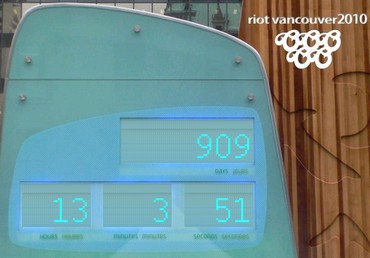

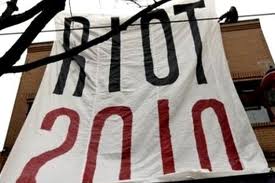

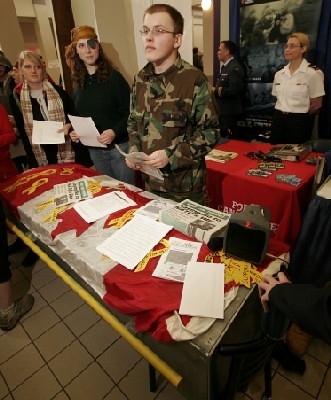
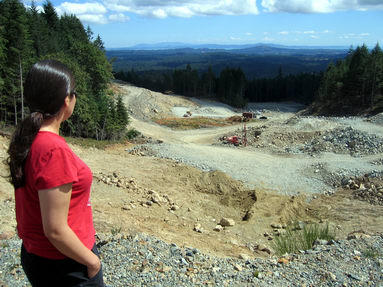



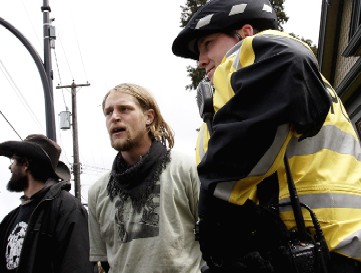
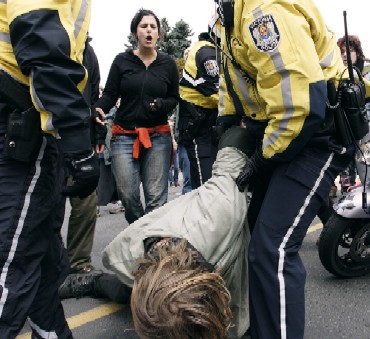
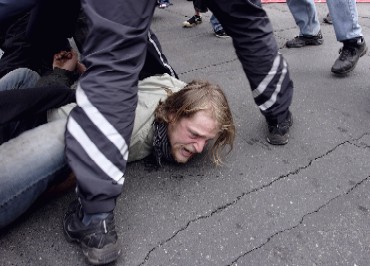

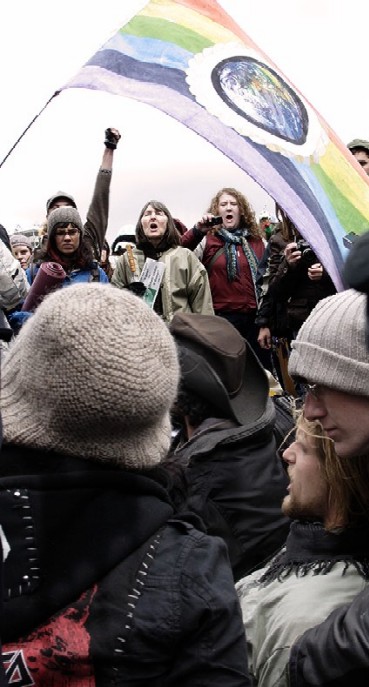
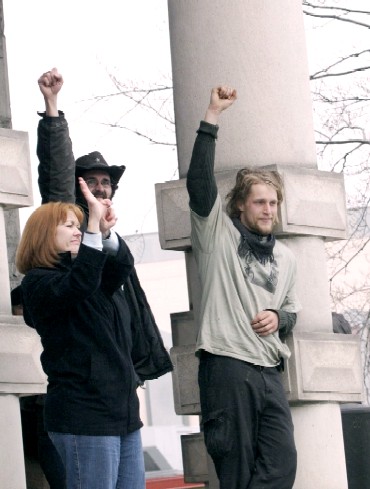

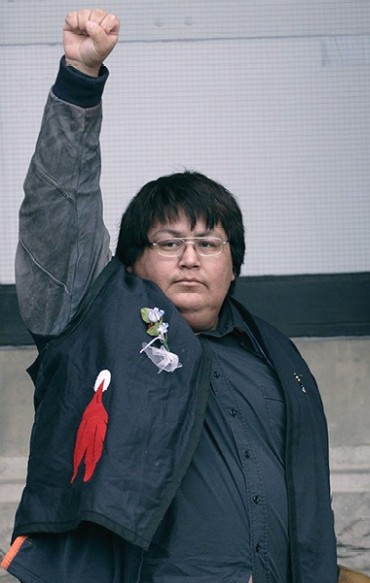
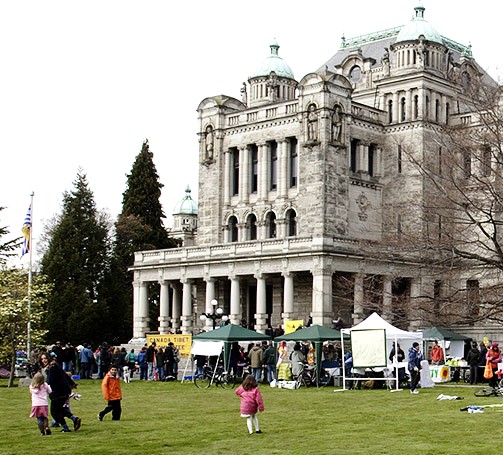
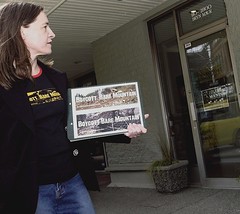
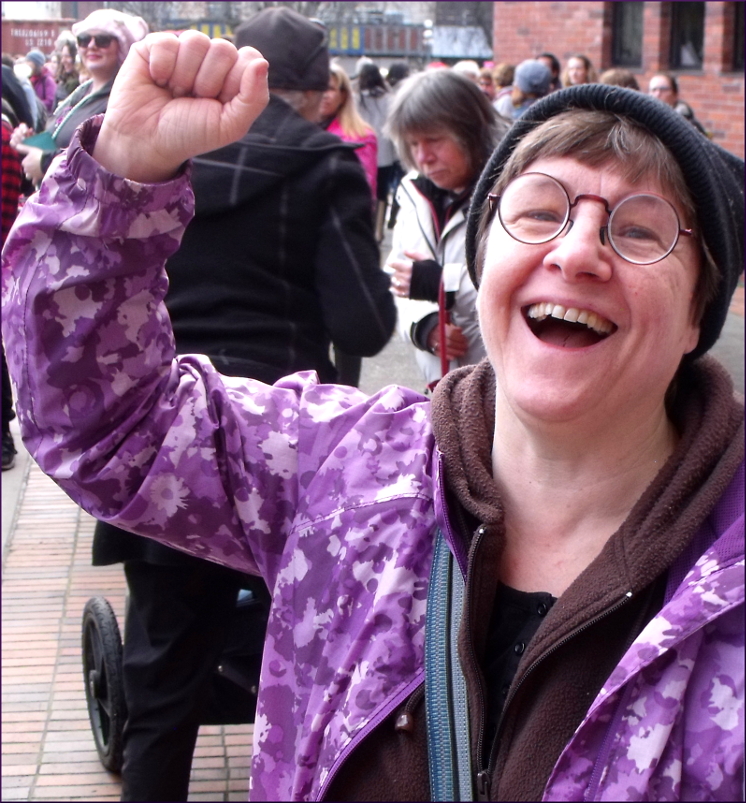 I get love letters. I get death threats. Out here in Canada’s Wild West, cold cash and brute force have mostly succeeded in subduing the land and anyone who tries to defend it.
I get love letters. I get death threats. Out here in Canada’s Wild West, cold cash and brute force have mostly succeeded in subduing the land and anyone who tries to defend it.
